Preparation of Copper Nanoplates in Aqueous Phase and Electrochemical Detection of Dopamine
Abstract
:1. Introduction
2. Materials and Methods
2.1. Materials
2.2. Synthesis of Cu Nanoplates
2.3. Electrochemical Detection of Dopamine
2.4. Characterizations
3. Results and Discussion
3.1. Characterization and Analysis of Copper Nanoplate
3.2. Electrochemical Behavior of Cu-GCE
3.3. Electrochemical Detection of Dopamine in Cu-GCE
3.4. Selectivity and Stability of Cu-GCE in Electrochemical Detection of Dopamine
4. Conclusions
Author Contributions
Funding
Institutional Review Board Statement
Informed Consent Statement
Data Availability Statement
Acknowledgments
Conflicts of Interest
References
- Chen, S.; Yuan, R.; Chai, Y.; Hu, F. Electrochemical sensing of hydrogen peroxide using metal nanoparticles: A review. Microchim. Acta 2013, 180, 15–32. [Google Scholar] [CrossRef]
- Gong, S.; Xiao, X.; Sam, D.K.; Liu, B.; Wei, W.; Yu, W.; Lv, X. Dispersed copper nanoparticles promote the electron mobility of nitrogen-rich graphitized carbon aerogel for electrochemical determination of 4-nitrophenol. Microchim. Acta 2019, 186, 853. [Google Scholar] [CrossRef] [PubMed]
- Gawande, M.B.; Goswami, A.; Felpin, F.X.; Asefa, T.; Huang, X.; Silva, R.; Zou, X.; Zboril, R.; Varma, R.S. Cu and Cu-based nanoparticles: Synthesis and applications in catalysis. Chem. Rev. 2016, 116, 3722–3811. [Google Scholar] [CrossRef] [PubMed] [Green Version]
- Wang, M.; Wang, X.; Liu, J.; Wei, J.; Shen, Z.; Wang, Y. 3-Dimensional ink printing of friction-reducing surface textures from copper nanoparticles. Surf. Coat. Technol. 2019, 364, 57–62. [Google Scholar] [CrossRef]
- Chomba, H.; Pan, T.; Zhuo, X.; Zhao, L.; Wang, Y.; Huang, Z.; Martin, H.; Chen, D.; Nie, L. A Bio-barcode electrochemical DNA biosensor based on poly T30 copper nanoparticle signaling. Sci. Adv. Mater. 2021, 13, 73–79. [Google Scholar] [CrossRef]
- He, Q.; Liu, J.; Liu, X.; Li, G.; Deng, P.; Liang, J. Preparation of Cu2O-reduced graphene nanocomposite modified electrodes towards ultrasensitive dopamine detection. Sensors 2018, 18, 199. [Google Scholar] [CrossRef] [Green Version]
- Ning, J.; He, Q.; Luo, X.; Wang, M.; Liu, D.; Wang, J.; Li, G.; Liu, J. Determination of uric acid in co-presence of dopamine and ascorbic acid using cuprous oxide nanoparticle-functionalized graphene decorated glassy carbon electrode. Catalysts 2018, 8, 407. [Google Scholar] [CrossRef] [Green Version]
- Lv, Z.; Wu, Y.; Dang, J.; Liu, D.; Hu, L.; Du, K.; Sun, H. Effect of yttrium on morphologies and size of tungsten carbide particles prepared through CO reduction. J. Mater. Res. Technol. 2020, 9, 10166–10174. [Google Scholar] [CrossRef]
- Li, N.; Yuan, K.; Gao, T.; Li, S.; Qin, J.; Zhu, Y.; Du, J.; Xu, J. Controllable synthesis of hierarchical nanoporous carbon@Ni(OH)2 rambutan-like composite microspheres for high-performance hybrid supercapacitor. Arab. J. Chem. 2022, 15, 103580. [Google Scholar] [CrossRef]
- Wu, Y.; Lu, Z.; Sun, H.; Dang, J. Production of different morphologies and size of metallic W particles through hydrogen reduction. J. Mater. Res. Technol. 2019, 8, 4687–4698. [Google Scholar] [CrossRef]
- Xie, H.; Li, N.; Chen, X.; Jiang, J.; Zhao, X. Surface oxygen vacancies promoted photodegradation of benzene on TiO2 film. Appl. Surf. Sci. 2020, 511, 145597. [Google Scholar] [CrossRef]
- Yang, S.; Qian, L.; Ping, Y.; Zhang, H.; Li, J.; Xiong, B.; Fang, P.; He, C. Electrochemical performance of Bi2O3 supercapacitors improved by surface vacancy defects. Ceram. Int. 2021, 47, 8290–8299. [Google Scholar] [CrossRef]
- Maji, N.C.; Chakraborty, J. Gram-scale green synthesis of copper nanowire powder for nanofluid applications. ACS Sustain. Chem. Eng. 2019, 7, 12376–12388. [Google Scholar] [CrossRef]
- Yang, H.J.; He, S.Y.; Chen, H.L.; Tuan, H.Y. Monodisperse copper nanocubes: Synthesis, self-assembly, and large-area dense-packed films. Chem. Mater. 2014, 26, 1785–1793. [Google Scholar] [CrossRef]
- Liu, X.; Yang, C.; Yang, W.; Lin, J.; Zhou, X.; Li, Y. Cu nanoplates with “clean surface”: Synthesis and their enhanced biosensors performance. J. Ind. Eng. Chem. 2022, 108, 476–483. [Google Scholar] [CrossRef]
- Powar, N.S.; Patel, V.J.; Pagare, P.K.; Pandav, R.S. Cu nanoparticle: Synthesis, characterization and application. Chem. Methodol. 2019, 3, 457–480. [Google Scholar]
- Pastoriza-Santos, I.; Sánchez-Iglesias, A.; Rodríguez-González, B.; Liz-Marzán, L.M. Aerobic synthesis of Cu nanoplates with intense plasmon resonances. Small 2019, 5, 440–443. [Google Scholar] [CrossRef]
- Xu, S.; Sun, X.; Ye, H.; You, T.; Song, X.; Sun, S. Selective synthesis of copper nanoplates and nanowires via a surfactant-assisted hydrothermal process. Mater. Chem. Phys. 2010, 120, 1–5. [Google Scholar] [CrossRef]
- Lee, J.W.; Han, J.; Lee, D.S.; Bae, S.; Lee, S.H.; Lee, S.K.; Moon, B.J.; Kim, T.W. 2D single-crystalline copper nanoplates as a conductive filler for electronic ink applications. Small 2018, 14, 1703312. [Google Scholar] [CrossRef]
- Tang, Z.; Kwon, H.; Yi, M.; Kim, K.; Han, J.W.; Kim, W.S.; Yu, T. Role of halide ions for controlling morphology of copper nanocrystals in aqueous solution. ChemistrySelect 2017, 2, 4655–4661. [Google Scholar] [CrossRef]
- Grouchko, M.; Kamyshny, A.; Ben-Ami, K.; Magdassi, S. Synthesis of copper nanoparticles catalyzed by pre-formed silver nanoparticles. J. Nanoparticle Res. 2009, 11, 713–716. [Google Scholar] [CrossRef]
- Jiang, Z.; Zhang, Q.; Zong, C.; Liu, B.J.; Ren, B.; Xie, Z.; Zheng, L. Cu–Au alloy nanotubes with five-fold twinned structure and their application in surface-enhanced Raman scattering. J. Mater. Chem. 2012, 22, 18192–18197. [Google Scholar] [CrossRef]
- Salzemann, C.; Urban, J.; Lisiecki, I.; Pileni, M.P. Characterization and growth process of copper nanodisks. Adv. Funct. Mater. 2005, 15, 1277–1284. [Google Scholar] [CrossRef]
- Zhang, P.; Song, T.; Wang, T.; Zeng, H. Fabrication of a non-semiconductor photocatalytic system using dendrite-like plasmonic CuNi bimetal combined with a reduced graphene oxide nanosheet for near-infrared photocatalytic H2 evolution. J. Mater. Chem. A 2017, 5, 22772–22781. [Google Scholar] [CrossRef]
- Zheng, S.; Huang, Y.; Cai, J.; Guo, Y. Nano-copper-MWCNT-modified glassy carbon electrode for selective detection of dopamine. Int. J. Electrochem. Sci. 2013, 8, 12296–12307. [Google Scholar]
- Laviron, E. General expression of the linear potential sweep voltammogram in the case of diffusionless electrochemical systems. J. Electr. Chem. Interf. Electrochem. 1979, 101, 19–28. [Google Scholar] [CrossRef]
- He, Q.; Liu, J.; Liu, X.; Li, G.; Chen, D.; Deng, P.; Liang, J. Fabrication of amine-modified magnetite-electrochemically reduced graphene oxide nanocomposite modified glassy carbon electrode for sensitive dopamine determination. Nanomaterials 2018, 8, 194. [Google Scholar] [CrossRef] [Green Version]
- Li, J.; Yang, Z.; Yang, Y.; Li, S.; Yu, Q.; Xu, X.; Hu, X. Graphene–Au nanoparticles nanocomposite film for selective electrochemical determination of dopamine. Anal. Methods 2012, 4, 1725–1728. [Google Scholar] [CrossRef]
- Ma, Y.; Zhao, M.; Cai, B.; Wang, W.; Ye, Z.; Huang, J. 3D graphene network@WO3 nanowire composites: A multifunctional colorimetric and electrochemical biosensing platform. Chem. Commun. 2014, 50, 11135–11138. [Google Scholar] [CrossRef]
- Wang, Y.; Li, Y.; Tang, L.; Lu, J.; Li, J. Application of graphene-modified electrode for selective detection of dopamine. Electrochem. Commun. 2009, 11, 889–892. [Google Scholar] [CrossRef]
- Aravind, S.S.J.; Ramaprabhu, S. Dopamine biosensor with metal oxide nanoparticles decorated multi-walled carbon nanotubes. Nanosci. Methods 2012, 1, 102–114. [Google Scholar] [CrossRef]
- Fan, Y.; Lu, H.T.; Liu, J.H.; Yang, C.P.; Jing, Q.S.; Zhang, Y.X.; Yang, X.K.; Huang, K.J. Hydrothermal preparation and electrochemical sensing properties of TiO2–graphene nanocomposite. Colloids Surf. B Biointerfaces 2011, 83, 78–82. [Google Scholar] [CrossRef] [PubMed]
- Li, J.; Xia, J.; Zhang, F.; Wang, Z.; Liu, Q. A Novel Electrochemical sensor based on copper-based metal-organic framework for the determination of dopamine. J. Chin. Chem. Soc. 2018, 65, 743–749. [Google Scholar] [CrossRef]
- Sakthinathan, S.; Chen, S.M.; Liao, W.C. Multiwalled carbon nanotube supported Schiff base copper complex inorganic nanocomposite for enhanced electrochemical detection of dopamine. Inorg. Chem. Front. 2017, 4, 809–819. [Google Scholar] [CrossRef]
- Sundar, S.; Venkatachalam, G.; Kwon, S.J. Biosynthesis of copper oxide (CuO) nanowires and their use for the electrochemical sensing of dopamine. Nanomaterials 2018, 8, 823. [Google Scholar] [CrossRef] [Green Version]
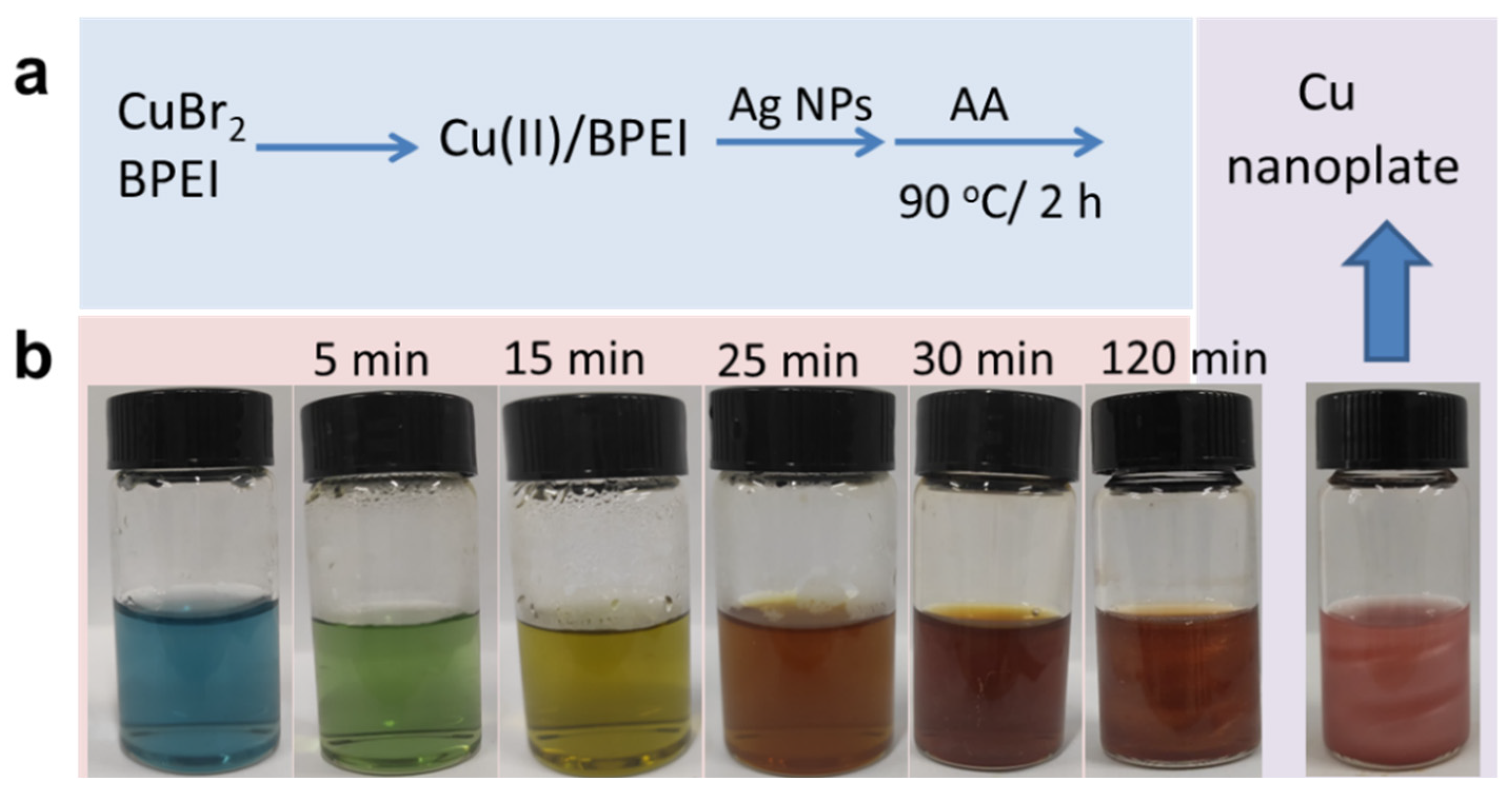
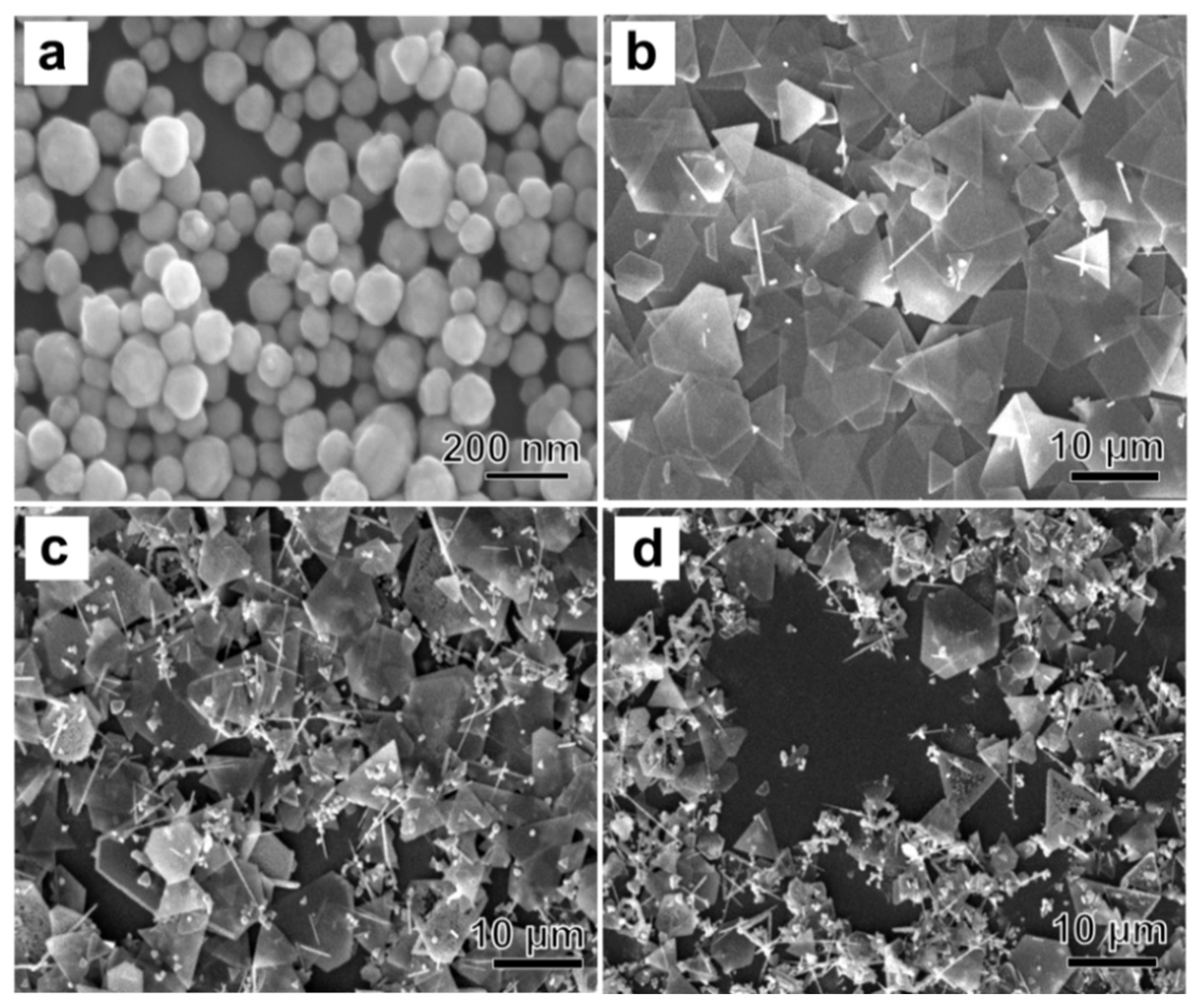
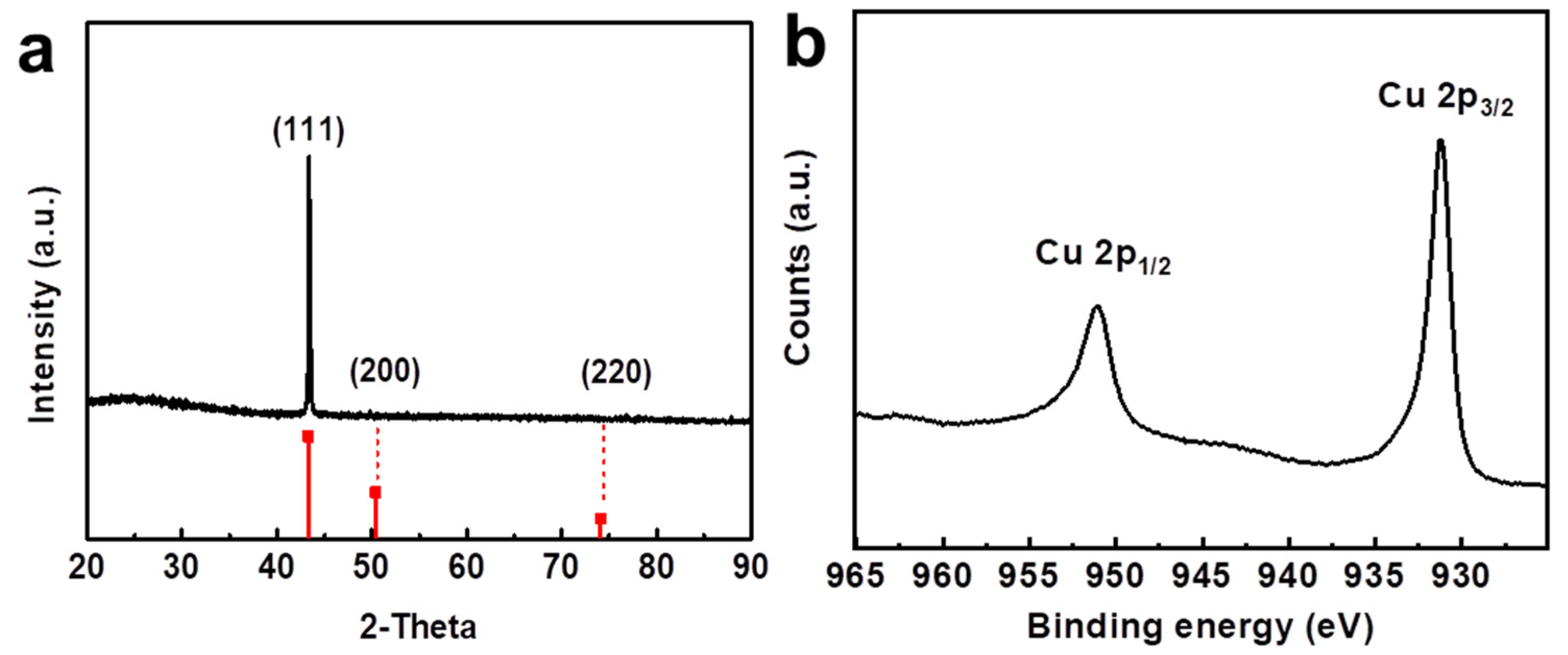
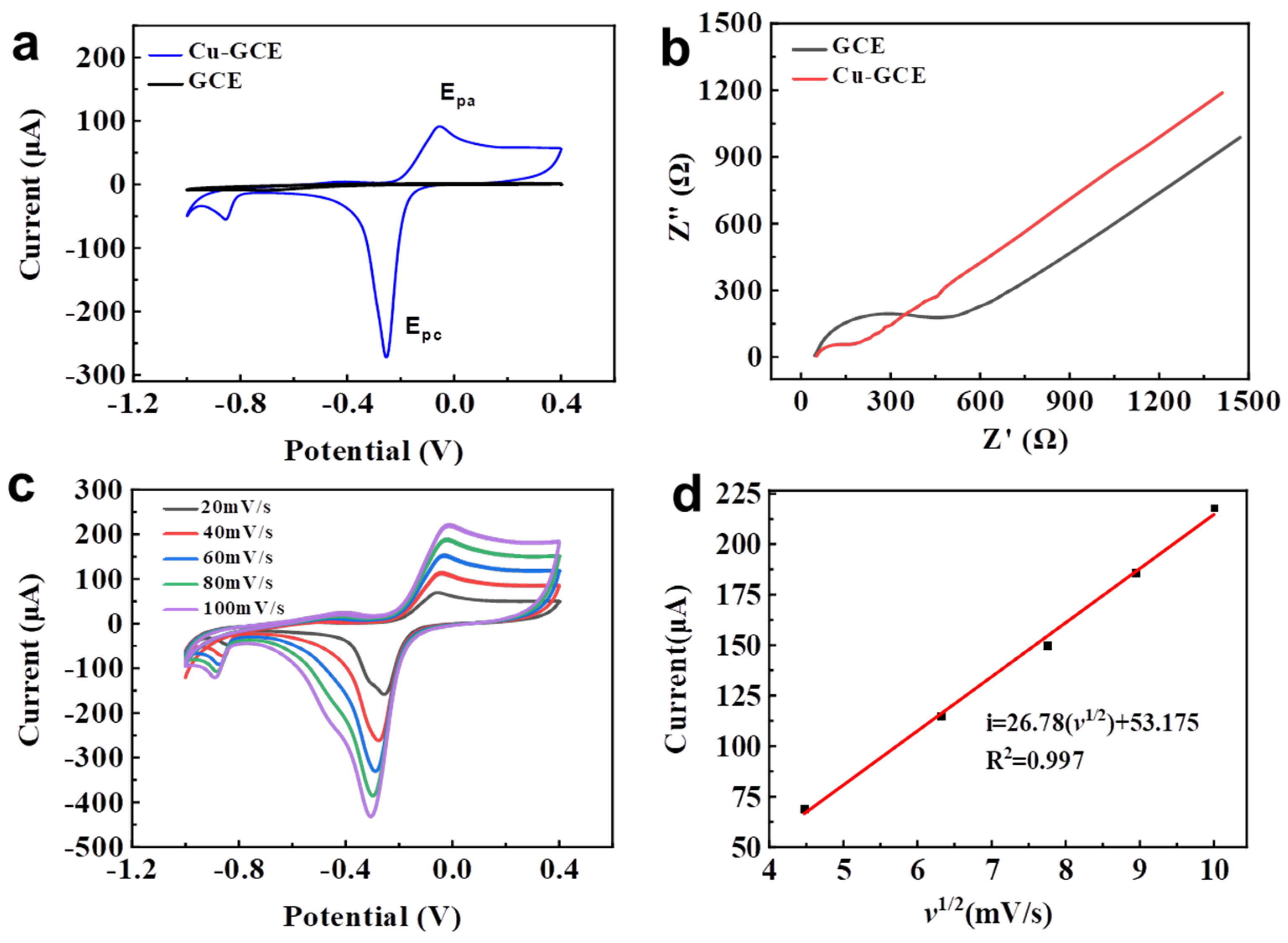

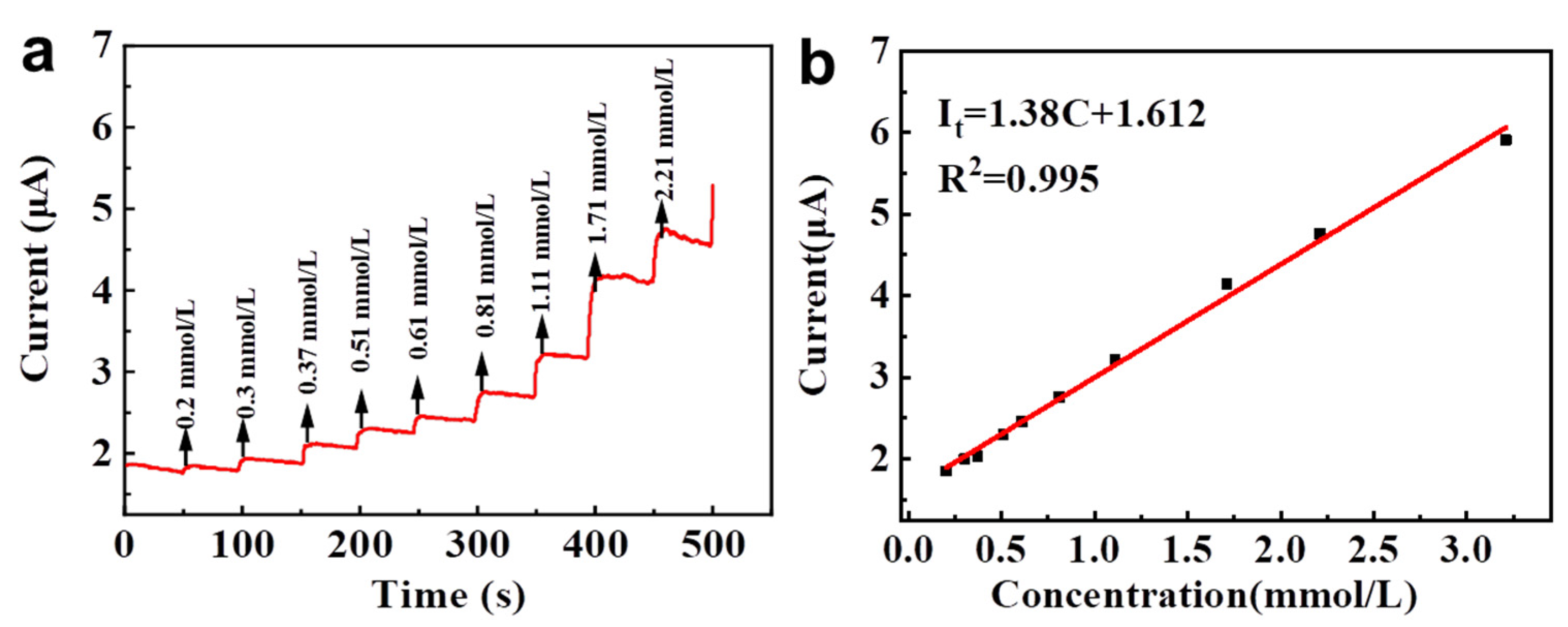
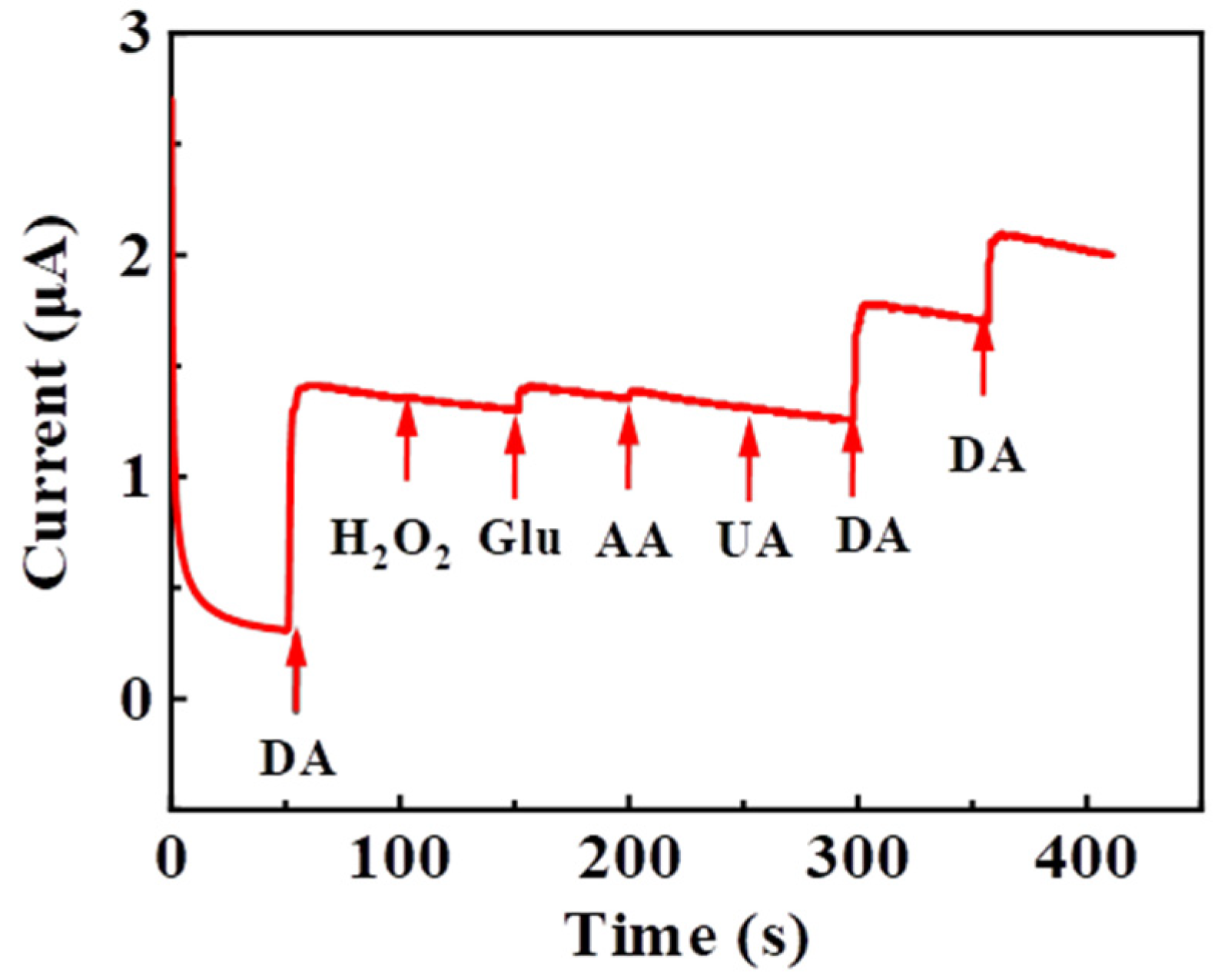

| Electrode | LOD | Linear Range | Ref. |
|---|---|---|---|
| Au-graphene | 1.86 mmol/L | 5–1000 mmol/L | [28] |
| 3D-GN@WO3 nanowire | 238 μmol/L | 10–150 mmol/L | [29] |
| Graphene | 2.64 mmol/L | 4–100 mmol/L | [30] |
| ZnO/MWNTs/GCE | 3 μmol/L | 3–200 μmol/L | [31] |
| TiO2/Graphene | 2 μmol/L | 5–200 μmol/L | [32] |
| Cu3(BTC)2/GCE | 15 μmol/L | 0.5–100 μmol/L | [33] |
| MWCNT/(Cu(sal-ala)bpy)/GCE | 2.34 μmol/L | 0.1–300 μmol/L | [34] |
| Cu2O-RGO/GCE | 6 nmol/L | 1–100 μmol/L | [6] |
| CuO nanowires/GCE | 0.1 μmol/L | 0.1–105 μmol/L | [35] |
| Cu nanoplate/GCE | 62.4 μmol/L | 0.2–2.21 mmol/L | This work |
Publisher’s Note: MDPI stays neutral with regard to jurisdictional claims in published maps and institutional affiliations. |
© 2022 by the authors. Licensee MDPI, Basel, Switzerland. This article is an open access article distributed under the terms and conditions of the Creative Commons Attribution (CC BY) license (https://creativecommons.org/licenses/by/4.0/).
Share and Cite
Xu, L.; Tang, S.; Zhang, L.; Du, J.; Xu, J.; Li, N.; Tang, Z. Preparation of Copper Nanoplates in Aqueous Phase and Electrochemical Detection of Dopamine. Life 2022, 12, 999. https://doi.org/10.3390/life12070999
Xu L, Tang S, Zhang L, Du J, Xu J, Li N, Tang Z. Preparation of Copper Nanoplates in Aqueous Phase and Electrochemical Detection of Dopamine. Life. 2022; 12(7):999. https://doi.org/10.3390/life12070999
Chicago/Turabian StyleXu, Lijian, Sijia Tang, Ling Zhang, Jingjing Du, Jianxiong Xu, Na Li, and Zengmin Tang. 2022. "Preparation of Copper Nanoplates in Aqueous Phase and Electrochemical Detection of Dopamine" Life 12, no. 7: 999. https://doi.org/10.3390/life12070999
APA StyleXu, L., Tang, S., Zhang, L., Du, J., Xu, J., Li, N., & Tang, Z. (2022). Preparation of Copper Nanoplates in Aqueous Phase and Electrochemical Detection of Dopamine. Life, 12(7), 999. https://doi.org/10.3390/life12070999






